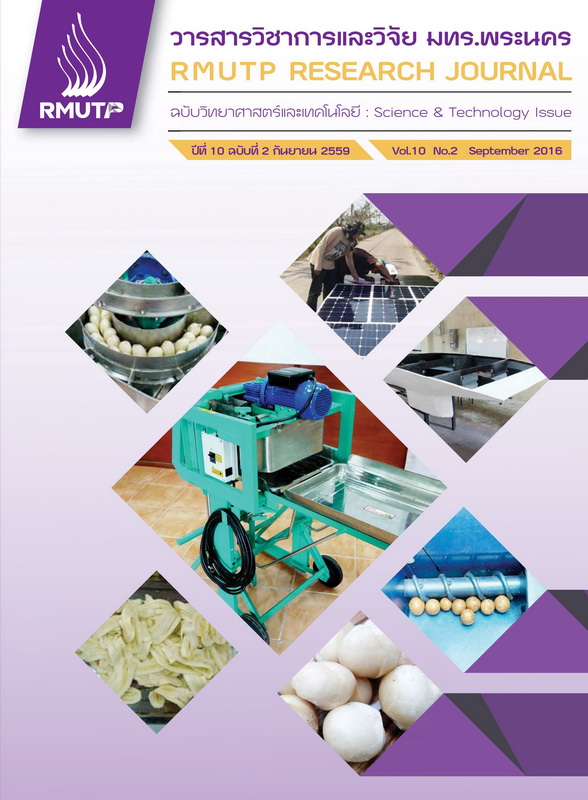สมบัติการบวมตัวของพอลิเอทิลีนความหนาแน่นสูงหลอมเหลวในหัวขึ้นรูปแบบวงแหวน Extrudate Swell Properties of High Density Polyethylene Melts in Annular Die
Main Article Content
Abstract
บทคัดย่อ
งานวิจัยนี้ได้นำเสนอการศึกษาสมบัติการบวมตัวของพอลิเอทิลีนความหนาแน่นสูงหลอมเหลวในหัวขึ้นรูปแบบวงแหวน ซึ่งถูกอัดรีดในเครื่องคาปิลารี่รีโอมิเตอร์ผ่านหัวขึ้นรูปแบบวงแหวน 3 รูปแบบได้แก่ หัวขึ้นรูปวงแหวนแบบธรรมดา หัวขึ้นรูปวงแหวนแบบลู่เข้า และหัวขึ้นรูปวงแหวนแบบลู่ออก โดยแต่ละชนิดของหัวขึ้นรูปกำหนดให้มีขนาดช่องการไหล 1 มิลลิเมตร 1.5 มิลลิเมตร และ 2 มิลลิเมตร ตามลำดับ ผลการทดลองพบว่าการบวมตัวของพอลิเอทิลีนความหนาแน่นสูงหลอมเหลวทั้งในแบบตามขนาดเส้นผ่านศูนย์กลางและแบบด้านความหนาที่ตรวจวัดได้ในระบบหัวขึ้นรูปทั้งสามแบบรูปมีแนวโน้มเพิ่มขึ้นตามการเพิ่มขึ้นของอัตราเฉือน และมีค่าเพิ่มขึ้นตามการลดลงของขนาดช่องการไหลจาก 2 มิลลิเมตรเป็น 1.5 มิลลิเมตร และ 1 มิลลิเมตรตาม ลำดับโดยเฉลี่ยร้อยละ 12% โดยสามารถอธิบายได้จากการตรวจวัดสมบัติการไหลในหัวขึ้นรูปทั้งสามแบบที่มีค่าความเค้นเฉือนเพิ่มตามการลดลงของขนาดช่องการไหลใกล้เคียงกันเฉลี่ยร้อยละ 10% นอกจากนี้ยังพบว่าการบวมตัวแบบด้านความหนามีค่าสูงกว่าการบวมตัวแบบตามขนาดเส้นผ่านศูนย์กลางเฉลี่ยแล้วร้อยละ 45% ในทุก ๆ ขนาดช่องการไหล ซึ่งสามารถอธิบายได้จากการกระจายตัวของค่าความเค้นที่มีความหนาแน่นบริเวณผิวแกนแมน-ดเร็ลเมื่อมีการลดลงของขนาดช่องการไหลในหัวขึ้นรูปแบบวงแหวน
Abstract
This research presents a study about extrudate swell properties of high density polyethylene melts in annular die, extruded in a capillary rheometer through 3 types of annular die: normal annular die, convergent annular die and divergent annular die. Each type of die had a die gap of 1mm, 1.5 mm and 2 mm, respectively. Results of the experiment showed that extrudate swell of high density polyethylene melts occurred in both diameter swell and thickness swell ratio. The swell measured in all 3 types of die tended to be higher with the increase of shear rate and the decrease of 2 mm, 1.5 mm to 1 mm die gap by an average of 12%. This occurrence could be explained from measurement of flow properties in all 3 types of die which had increasing shear stress due to the decrease of die gap by an average of 10%. Moreover, it was also found that the thickness swell ratio was higher than the diameter swell by an average of 45% in all sizes of die gap. This could be explained from the Stress distribution which was more dense at the mandrel's surface when the die gap of annular die decreased.

